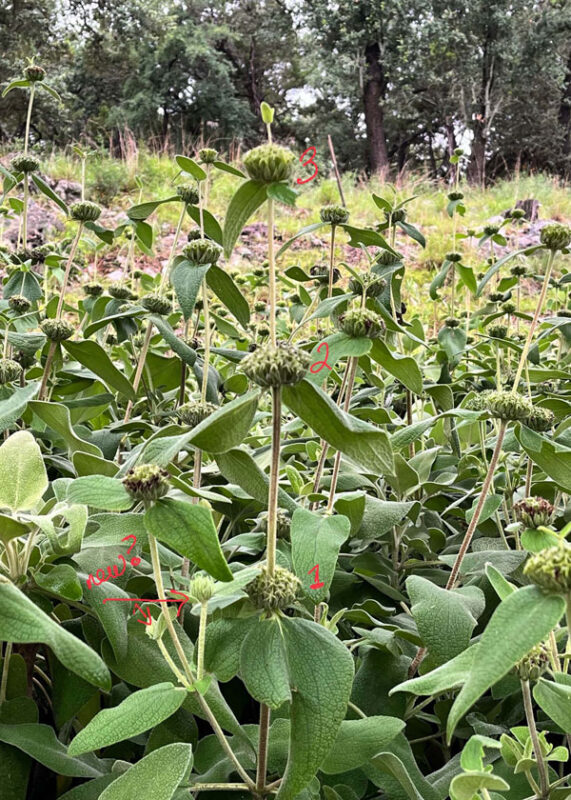Q&A – Ask Neil: June 19, 2025
(Please read these instructions carefully.)
Before you post your question, please look at recent issues to see if someone else has already asked it. You might find your answer there.
How to submit your question…
(Note: You may need to allow a pop-up window to come up in order to get the link for sending your photo(s). If you have already submitted your question and didn’t see the pop-up window, please click here.)
• Click the link provided below to post your question. After you submit your question, a new window will pop up giving you the address to which you can e-mail a SHARP, HIGH-RESOLUTION PHOTO to accompany your question. Please DO NOT SEND THUMBNAIL PHOTOS in case I need to zoom in to see things.
• Click here to post your question.
• Please ONLY POST YOUR QUESTION ONE TIME. We can only accept a set number of questions each week, and when we get duplicates it costs other people their chances.
• One question per reader, please.
• Please use this only for posting questions – not for standard emails.
• Watch for your answer in the following week’s e-gardens.
• I choose those of greatest general interest. For example, plant IDs seldom make the cut.
• I must have your first name or initials.
• I must have your city or county. (Texas is a very large state.)
IMPORTANT NOTE: I’m going to ask, after this week, for a moratorium on questions about live oaks losing chunks of bark. I know it’s an important question to many of our readers, but it has come up almost weekly. I’ll be posting information on it after this week, but for now you can see answers to two readers’ questions below. Thanks!
QUESTION 1
WHEN SHOULD I TRIM THE OLD BLOOMS OFF MY JERUSALEM SAGE?
Question: When should the old blooms be trimmed off a Jerusalem sage? It had up to four tiers of flowers earlier this season, but the yellow flowers are gone now. Should I remove them before they turn brown? Lauri L., Boerne.
Answer: Deadhead the blooms now by pruning back to the base of each flowering stalk. Use sharp shears for clean cuts. You actually could have done this pruning a few weeks earlier – as soon as the last yellow flowers had faded. Reshape the plants gently as you trim them but avoid really heavy pruning. All this may stimulate light second round-blooming later this season. (I did not see reference in your note to the numbers you had inserted on your digital photo.)
QUESTION 2
SHOULD I USE DRIP IRRIGATION OR SPRINKLERS ON MY NEW BEDS?
Question: I redid two large landscape beds in my backyard. (30 ft. x 7 ft. and 20 ft. x 8 ft.) Should I use drip irrigation for the drought-tolerant plants I used, or would sprinklers be better? Red yuccas, Japanese aralias, Mexican feathergrass, stonecrop sedum, summer phlox, variegated liriope, oleander, and daylilies. How many times per week and for how long should I run the system? Robyn O., Plano.
Answer: Really nice work and a lovely setting/backdrop. It’s a bit after-the-fact to think about installing a sprinkler system, as that would involve digging trenches. I am cave-man old-fashioned, but I still prefer sprinklers because I can see them at work and make adjustments as needed. But many cities now require drip systems in beds. Check with the Plano regulations before you do anything. Drip irrigation can work, as evidenced by all the beautiful landscapes in arid parts of America and the world. But it’s very easy for drippers to get chewed or dislodged and plants to be lost before we know it. Water by hand for a while as you do your homework on how best to install a drip system.
As far as how often and how long to run any irrigation system, there are many variables that make that answer quite difficult: type of soil and bed preparation, types of plants, sun or shade, recent rainfall, temperature, etc. You need to be the one who determines the right time to water. When you do water, soak the soil deeply. It takes a drip system much longer than many people expect to water to the bottoms of original soil balls. You really need to water by hand for the first year to get your plants established.
Side note: I do not consider aralias to be “drought tolerant.” Nor is it fond of direct sunlight. I know those plants are expensive. You may have a shaded spot in your landscape where they would be better suited. I’d put variegated liriope in that same category.
QUESTION 3
WHY IS BARK SPLITTING OFF MY LIVE OAK IN PAST FEW MONTHS?
Question: These sections of bark have shown up on my live oak within the past few months. The tree is 20 years old. What’s causing it, and should I be worried? Mahannah P., Fort Worth.
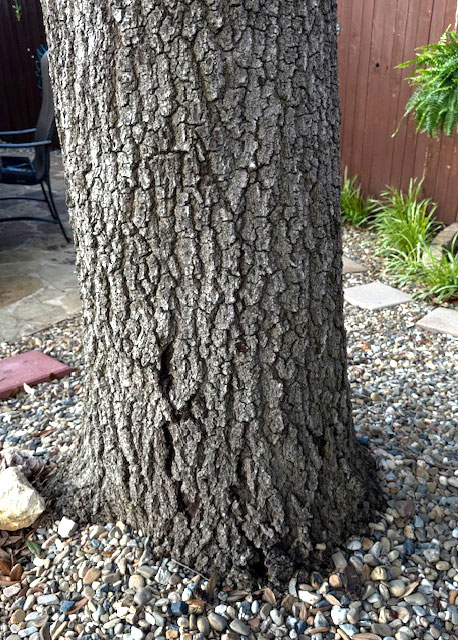
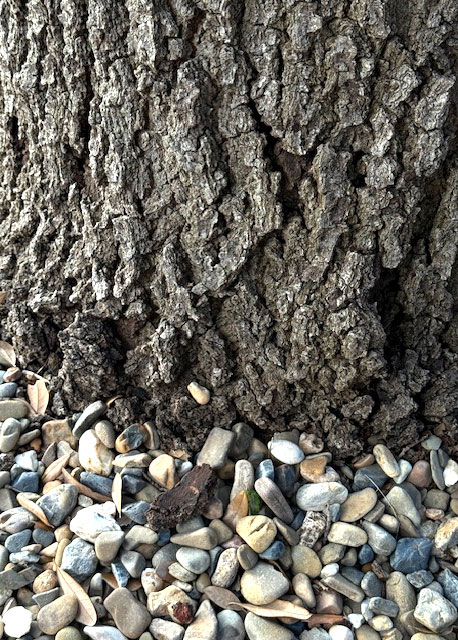
Answer: I have two answers, but I can’t fine-tune to the correct one from the photos. Bark is a dead tissue, so as a tree grows and its trunk gets larger in diameter, the bark pops off and falls to the ground. That may be going on here, and if so, that’s a natural occurrence and the tree should be just fine.
However, I have seen hundreds of photos just like yours since February 2021 and the severe cold spell. A phenomenon known as “radial shake” caused bark to separate and take critical internal tissues with it. In most cases it happened within the first year or two, but in some cases, it’s just now showing up.
The top of the tree (canopy) is your best clue. If you can see that it is thinning and limbs appear to dying gradually, that would be a bad sign.
Your best course is to get a certified arborist on site as soon as possible to give the tree a complete check-up. Do not attempt to trim or peel the loose bark away. You will end up doing more damage than you want. Leave it to the pros. Our advertiser here Arborilogical Services does serve your area. No one is any better. Good luck with the tree!
QUESTION 4
WHAT CARE SHOULD I BE GIVING MY NEW PALMETTO ST. AUGUSTINE?
Question: I had new Palmetto St. Augustine planted on March 29. I knew it was susceptible to gray leaf spot, and now, due to all the rain, it has it. I had been mulching clippings, but with the magnolia leaf drop I decided to catch them rather than putting them back into the turf. I’m alternating between propiconazole and azoxystrobin every couple of weeks. Is that a good plan? No fertilizer until early September. Russell B., Frisco.
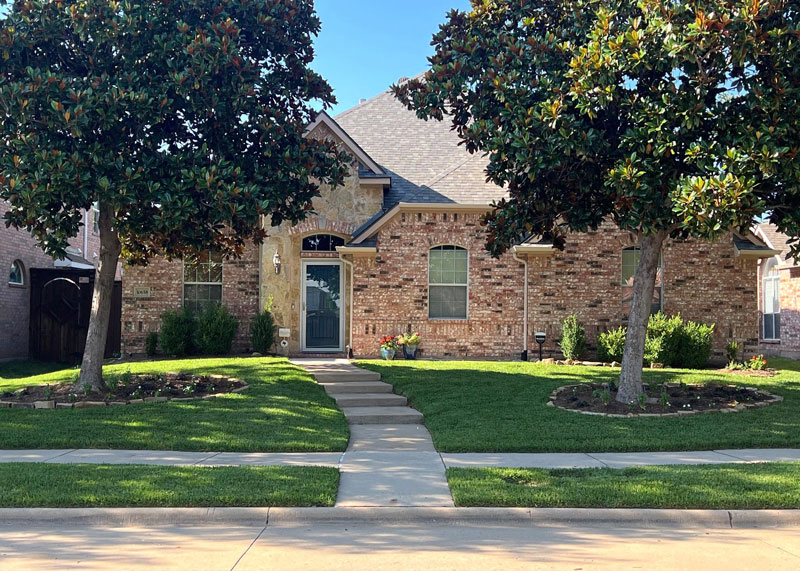
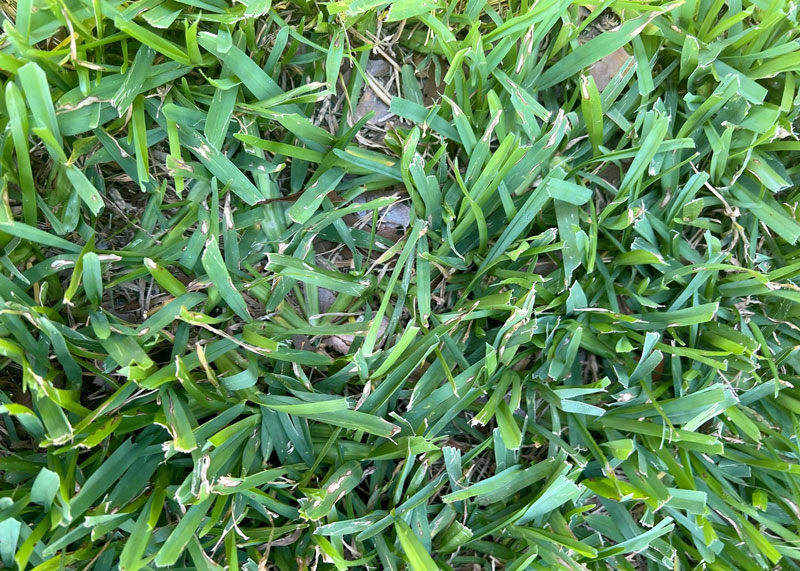
Answer: I’d give you “thumbs up.” Actually, the gray leaf spot is quite minor still, so I think the grass will outgrow it. I’m more concerned about the amount of shade those handsome magnolias are casting onto the grass. I guess I’m just a natural-born worrier. But your feeding plan is perfect. I doubt if you will need to apply fungicides that often.
Note: Russell gave me a very comprehensive schedule of what he has applied and when he applied it. He has kept fastidious records. If all gardeners could be half this well organized!
QUESTION 5
IS THIS POWDERY MILDEW? IS INSECTICIDAL SOAP THAT TARGETS POWDERY MILDEW THE CORRECT ACTION?
Question: I have two crape myrtles that are 3-4 years old. I noticed white patches on their new growth and think it’s powdery mildew. I sprayed an insecticidal soap that targets powdery mildew. Was this the correct action? Kevin A., Van Alstyne.
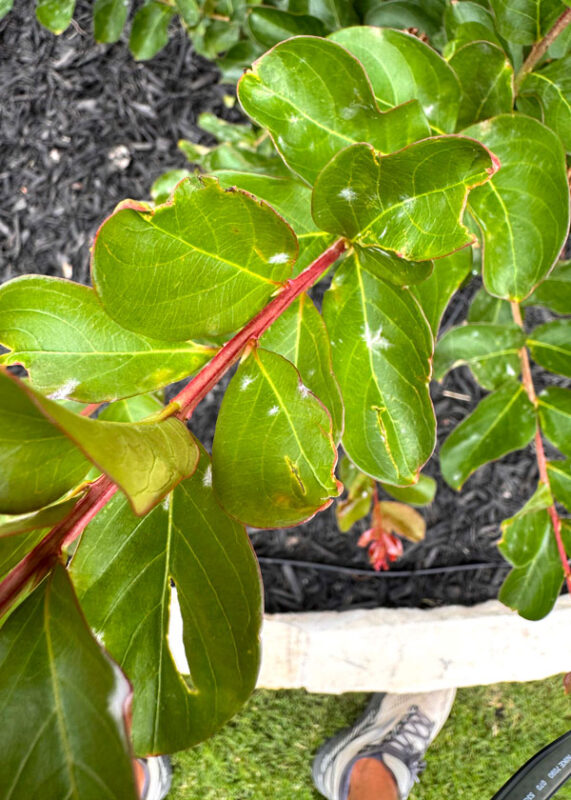
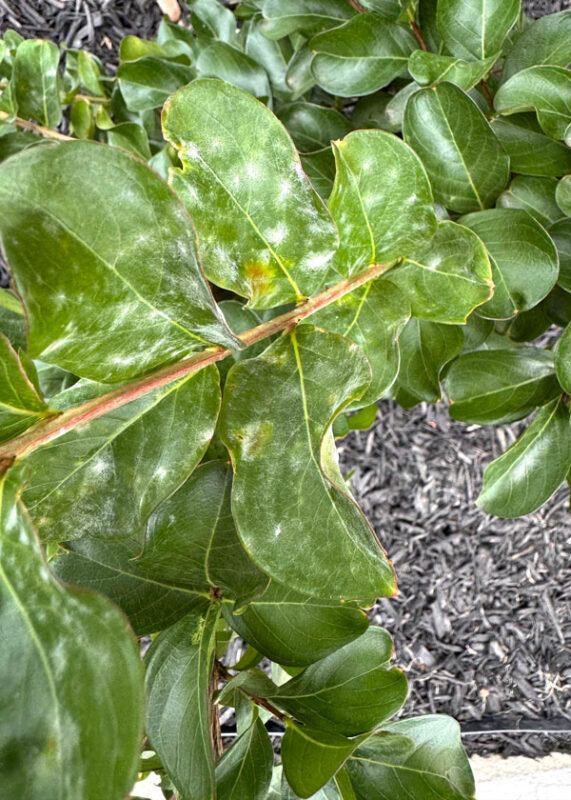
Answer: Your assessment is correct. Powdery mildew it is – long the bane of crape myrtles in the South. The good news is that it has never killed a crape myrtle. The worst damage it will do is to ruin the first round of blooms in late May or early June.
Powdery mildew was always present on older varieties of Lagerstroemia indica. Those were the types we all grew until the late 1970s. Then, the watershed breeding work of Dr. Don Egolf of the United States National Arboretum, brought genes from L. fauriei into the mix. That species is highly resistant, if not immune to mildew. So, if you buy a variety with an Indian tribal name, you’ll be getting one of Dr. Egolf’s 29 mildew-resistant selections. Other breeders, to one degree or another, have followed suit in their own breeding programs.
As for the insecticidal soap, if it’s labeled for control of mildew, then I guess it might help. However, by its name it sounds more like its intent is to control insects in your landscape and garden. There are excellent fungicides labeled for control of powdery mildew. A Texas Certified Nursery Professional could show you the options. Or, you can just wait it out. Once it turns hot and dry the mildew will run its course.
QUESTION 6
IS THERE ANYTHING THAT CAN BE DONE TO SAVE THIS OLD LIVE OAK?
Question: Is there anything that can be done to save this old live oak? Carolyn B., Ben Wheeler, Van Zandt County.
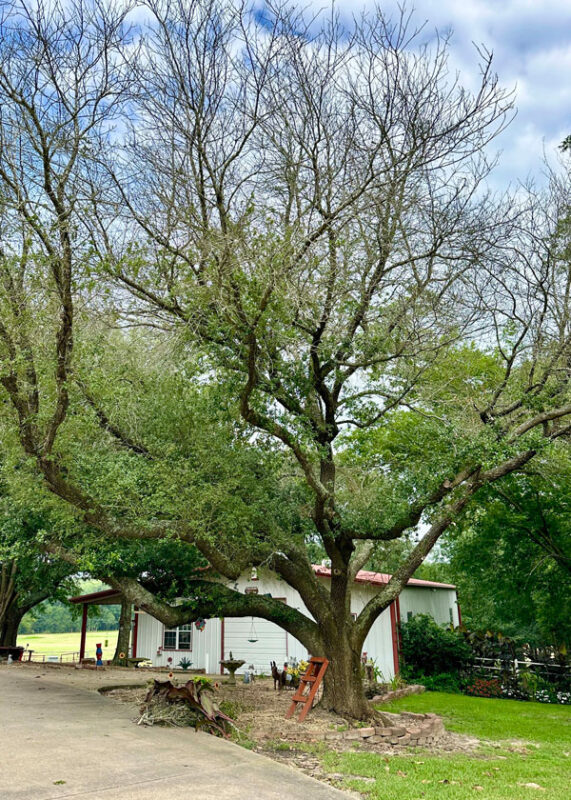

Answer: See my answer to the question from Mahannah above (Question 3). The second part of that answer regarding radial shake pertains to your tree. The fact that the top has lost so much of its leaf canopy tells us the tree is regressing seriously. Keep a very close eye on it to be sure it doesn’t break and fall. It is very heavy and could do extreme damage and cause serious injury or death. Otherwise, all you can do is wait to see if it improves. Sadly, my worry is that it won’t.

